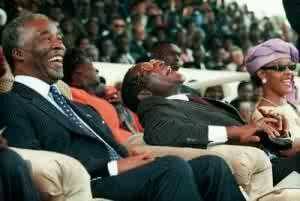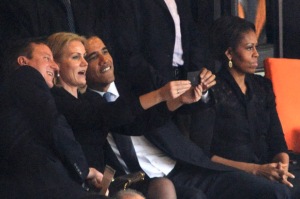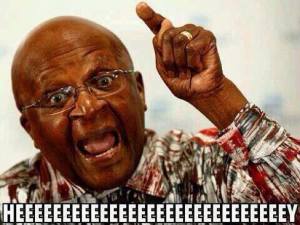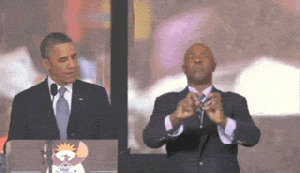Where were you during Nelson Mandela’s Memorial?
 It was an unusually hideous summer day in Johannesburg on Tuesday December 10th, the day of Nelson Mandela’s memorial at the FNB Stadium in Soweto. Cold, wet, and grey, the weather certainly defeated any stereotypes or expectations of perpetually sunny “African skies” for the international media broadcasting. The weather was so terrible, in fact, that it became a theme that heads of state played on in their speeches. Master of Ceremonies, Cyril Ramaphosa, apologised for the weather, saying that they could unfortunately not make it stop, but then spoke of the significance of rain in the context of death – that it symbolizes a life well lived, and the opening of the heavens. But, the conditions did not prevent hundreds of thousands of people from attending the memorial in the open stadium. Some of those interviewed on the news said that they were proud to be there, suffering in the rain and cold to honour the former President and struggle hero who had suffered so much for their freedom. I only live about 45 minutes away from the Stadium, but I did not attend for various reasons. I preferred to rather watch from my apartment and try to get some work done as I watched the memorial. However, as the memorial coverage began, and the social media began to roll, I became completely engrossed in the social media commentary on the event. Work tossed aside – just for the day.
It was an unusually hideous summer day in Johannesburg on Tuesday December 10th, the day of Nelson Mandela’s memorial at the FNB Stadium in Soweto. Cold, wet, and grey, the weather certainly defeated any stereotypes or expectations of perpetually sunny “African skies” for the international media broadcasting. The weather was so terrible, in fact, that it became a theme that heads of state played on in their speeches. Master of Ceremonies, Cyril Ramaphosa, apologised for the weather, saying that they could unfortunately not make it stop, but then spoke of the significance of rain in the context of death – that it symbolizes a life well lived, and the opening of the heavens. But, the conditions did not prevent hundreds of thousands of people from attending the memorial in the open stadium. Some of those interviewed on the news said that they were proud to be there, suffering in the rain and cold to honour the former President and struggle hero who had suffered so much for their freedom. I only live about 45 minutes away from the Stadium, but I did not attend for various reasons. I preferred to rather watch from my apartment and try to get some work done as I watched the memorial. However, as the memorial coverage began, and the social media began to roll, I became completely engrossed in the social media commentary on the event. Work tossed aside – just for the day.
A discursive explosion occurred when the death of Madiba was announced on December 5th, and predictably, it was one of sadness and loss, swathed in respect and honour, and completely focussed on Nelson Mandela. A few more critical memes did grace the scene, such as this one, which refers to Mandela’s neoliberal shift to GEAR (Growth Employment and Redistribution), and away from the more socialist RDP (Reconsturuction & Development Programme) after coming into office. 
The occasion of the internationally broadcasted memorial sprouted new discourses – the world was watching the memorial, and people from different parts of the world are participating in the building of these discourses together. Twitter, unsurprisingly, was an important cyber space where these discourses took shape with trends like #MadibaMemorial, and #FNBStadium. The world did not participate evenly of course, given that an enormous percentage of the world does not have access to social media technologies. Nevertheless, participatation in the discursive event of Nelson Mandela’s memorialisation took place at the international level. This post is dedicated to the creative social media that has blossomed out of the worlds mourning of Madiba, an individual who has in life and memory brought together people from opposing political views and different walks of life.
I feel like if you are reading this post, you have access to the internet and forms of media, meaning that I do not need to tell you what happened at the Soweto memorial. But, for posterity, and clarity, I will provide a selective re-telling of the events.
The “Rain-Boo-Nation”: Jacob Zuma on the big screen and the “boo” heard round the world
The entrance of international heads of state, dignitaries, and occasional celebrity, into the stadium was broadcast on the big screen in the stadium. Sometimes, this image matched the one we were watching at home, and sometimes it did not. So, in telling what happened, I am also relying on accounts provided by people inside the stadium. Of course, Charlese Theron, Bono, and Thabo Mbeki received enormous applause as they entered the stadium. Then, as Jacob Zuma entered, the began to curdle and froth. Boos erupted and spread like a wave across the stadium, cameras showing members of the crowd making a rolling hands motion, indicating the need for change. Instantly, social media went wild. While some people thought that the booing was hilarious and/or well deserved, most others reacted with disapproval, saying that the booing was an embarrassment for the country, and simply not appropriate to the occasion. The crowd was later placated by the entrance of the Clintons and Barack and Michelle Obama, who were met with an outpouring of adoration. Bush was certainly able to benefit from their popularity as he walked in with them. Watch it all go down here:
This photo, supposedly taken while Zuma was being booed, is apt (Mbeki and Mugabe were both greeted with warm welcomes from the crowd):
 And, not only did the crowd boo when Zuma entered the stadium, they booed every time his image appeared on the big screen. Ramaphosa had to discipline the crowd before Zuma came to the podium to make his closing speech, ordering them to save their grievances for later, and to show to the world that they could be “disciplined”. I saw one tweet saying that Cyril would make a great kindergarden teacher with that look of his, spectacles in his waving hand. A praise singer came on afterwards to work up the crowd, and it seemed like he was trying to make everyone remember why they supposedly like Zuma, the dancing and singing president. After the praise singer, Zuma began to approach the podium. Again, the previous cheering from the crowd melted once again into a low booooooooo. Quickly, the Soweto Gospel Choir began to sing, and from where I was sitting, it seemed like a well crafted attempt to drown out the booos. While the crowd listened respectfully to Zuma’s speech, the long running satirical cartoon Southpark, re-created the scene in an elementary school classroom, infusing the scene with new meanings.
And, not only did the crowd boo when Zuma entered the stadium, they booed every time his image appeared on the big screen. Ramaphosa had to discipline the crowd before Zuma came to the podium to make his closing speech, ordering them to save their grievances for later, and to show to the world that they could be “disciplined”. I saw one tweet saying that Cyril would make a great kindergarden teacher with that look of his, spectacles in his waving hand. A praise singer came on afterwards to work up the crowd, and it seemed like he was trying to make everyone remember why they supposedly like Zuma, the dancing and singing president. After the praise singer, Zuma began to approach the podium. Again, the previous cheering from the crowd melted once again into a low booooooooo. Quickly, the Soweto Gospel Choir began to sing, and from where I was sitting, it seemed like a well crafted attempt to drown out the booos. While the crowd listened respectfully to Zuma’s speech, the long running satirical cartoon Southpark, re-created the scene in an elementary school classroom, infusing the scene with new meanings.
Whether the booing was “appropriate” or not is irrelevant now. The fact is that it happened, and it has now punctuated the world’s memory of the Madiba memorial.
The Crowd
While the crowd was the backdrop from the vantage point of a home television from where most of the world watched, it was obvious that the crowd played an enormous role in the memorial. The booing for Zuma, contrasted with the loud cheering for other public figures – even Robert Mugabe – provides the soundscape to the memorial. Images of recognisable VIP members of the crowd, like heads of state, especially those from the US, became prominent characters in the discourse that proliferated during and the days following the memorial. This image, when I saw it on television, also struck me as a memorable one. It was taken during Obama’s speech, and shows the Clinton’s listening thoughtfully, while George W. sits back in his chair, red faced, and with a somewhat perplexed look on his face. I suspected he was thinking about his next cat painting. His wife, Laura, the political mouse she is, watches merrily:

Cats…?
Later, this image of Bush showing off his cat paintings on Air Force One was released. He really seems to be pleased with himself, and wanting the approval and praise from the fellow states-wo/men.
The coming together of otherwise oppositional world leaders at the memorial was remarkable. This image of Obama shaking the hand of Cuban President, Raul Castro was a huge deal in US and global media:
And Obama’s selfie with Danish Prime Minister Helle Thorning-Schmidt and British Prime Minister David Cameron, has been dubbed the “Obama Selfie-Face-Gate“, with the expression on Michelle’s face being a major point of interest amongst social media commentators. The photographer who took the photo confirms that she caught Michelle’s debatably ‘mournful’, ‘angry’, and/or ‘irritated’ expression purely by chance.
So scandalous, were the Raul Castro handshake and the Obama selfie-face gate, that they made the opening skit on Saturday Night Live on Saturday. You can decide if it is funny or not by watching it here:
Where were we again? Oh yes, a memorial for Nelson Mandela. The social media that has accompanied the memorial and continues to generate discourse about the event does seem to take our attention away from the task at hand at times… So yes, the crowd was full of energy, refusing to be tamed, despite the best efforts of the MC and former Arch Bishop, Desmond Tutu. Tutu’s demand that he wanted to hear “a pin drop” was a disaster, and he completely set himself up for failure. His cries, “YEAHHH!!” at the crowd when they refused to cooperate with his orders made for another memorable, memeable, moment:
The moment on the left sparked the meme on the right…

The “fake” Interpreter
In the days following the memorial, debate over the legitimacy of sign language interpreter, Thamsanqa Jangtjie Dyantyi, at the Soweto memorial has become a pretty big deal, and the dude is seriously getting ripped apart from all sides – there are even stories of him being a murderer coming out of the woodwork. International viewers and members of the South African public have complained publicly and vocally about Dyantyi’s interpretation, arguing that he was “a fake”. Subsequently, the interpreter has said that he is schitzophrenic and was suffering from the stress of interpreting for such a length of time and under such stressful circumstances. However, regardless of whether he is a “fake” or not, the interpreter has inspired a range of memes, some more clever and critical than others. This vine is a personal favourite that I can’t stop watching.
However, one of the most poignant memes about the interpreter is directed at Obama’s hypocritical speech. Before I show you that though, have a look at this meme which captures the contradictions so sincerely communicated by Obama with his infamously seductive rhetorical skills. While the crowd was oozing with love for Obama, it was easy to forget about what was being omitted from his eloquent speech:

But then, someone made this brilliant intervention in the interpreter saga, because it is just plain ridiculous to hear Obama condemning intolerance for dissent and to NOT call it out….drones…Manning…Snowden…Guantanamo…the list of contradictions goes on…





